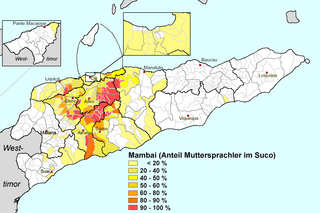
Tetum is an Austronesian language spoken on the island of Timor. It is one of the official languages of Timor-Leste and it is also spoken in Belu Regency and Malaka Regency, which form the eastern part of Indonesian West Timor adjoining Timor-Leste.
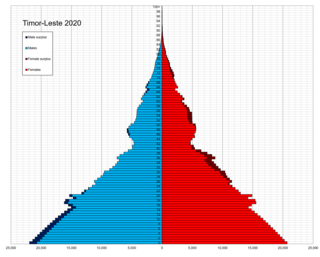
This is a demography of the population of Timor-Leste including population density, ethnicity, education level, health of the populace, economic status, religious affiliations and other aspects of the population.

Mirandese is an Asturleonese language or variety that is sparsely spoken in a small area of northeastern Portugal in eastern Tierra de Miranda. The Assembly of the Republic granted it official recognition alongside Portuguese for local matters with Law 7/99 of 29 January 1999. In 2001, Mirandese was officially recognised by the European Bureau for Lesser-Used Languages, which aims to promote the survival of the least spoken European languages.

The languages of Timor-Leste include both Austronesian and Papuan languages. The lingua franca and national language of Timor-Leste is Tetum, an Austronesian language influenced by Portuguese, with which it has equal status as an official language. The language of the Oecusse exclave is Uab Meto (Dawan). Fataluku is a Papuan language widely used in the eastern part of the country. A dialect of Malay-based creole called Dili Malay is spoken by a number of residents in the capital Dili, it borrowed words mostly from Portuguese and Tetum. Both Portuguese and Tetum have official recognition under the Constitution of Timor-Leste, as do other indigenous languages, including: Bekais, Bunak, Galoli, Habun, Idalaka, Kawaimina, Kemak, Lovaia, Makalero, Makasae, Mambai, Tokodede and Wetarese.

Aileu is a municipality, and was formerly a district, of East Timor. It has a population of 48,554 and an area of 737 km2. The municipality's capital is also named Aileu. Its administrative posts are Aileu, Laulara, Lequidoe and Remexio.

The People's Party of Timor is a conservative political party in East Timor. Its predecessor was the Movimento do Povo de Timor-Leste MPTL. The PPT is described as a conservative, backward-looking traditional party with utopian ideas and monarchist and religious tendencies.
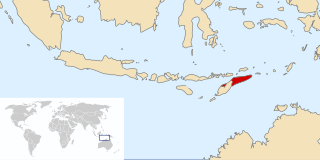
East Timor was a province of Indonesia between 1976 and 1999, during the Indonesian occupation of the country. Its territory corresponded to the previous Portuguese Timor and to the present-day independent country of East Timor.
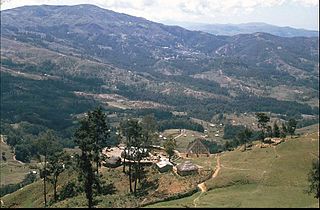
Manufahi is one of the municipalities of East Timor. It has a population of 53,691 and an area of 1,323 km2. The capital of the municipality is Same.
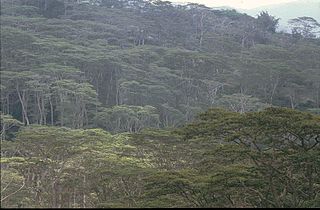
Ermera is one of the municipalities of East Timor, located in the west-central part of the country. It has a population of 117,064 and an area of 756.5 km2.
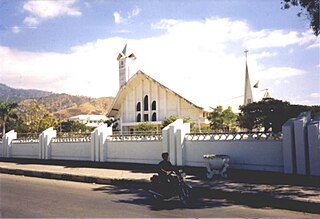
Dili Municipality is one of the 14 municipalities, formerly districts, of Timor-Leste, and includes the national capital Dili. The municipality had a population of 277,279 as of 2015, most of whom live in the capital city.

Ainaro is one of 13 municipalities of East Timor, in the southwest part of the country. It has a population of 59,175 and an area of 804 km2. Its capital is the city of Ainaro, a small mountain town.

The Bunak people are an ethnic group that live in the mountainous region of central Timor, split between the political boundary between West Timor, Indonesia, particularly in Lamaknen District and East Timor. Their language is one of those on Timor which is not an Austronesian language, but rather a Papuan language, belonging to the Trans–New Guinea linguistic family. They are surrounded by groups which speak Malayo-Polynesian languages, like the Atoni and the Tetum.
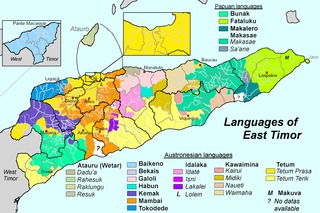
Atauran is an Austronesian language spoken on Atauro island and in Manatuto Municipality, East Timor. It is closely related to Wetarese and Galoli.

Geoffrey Stephen Hull is an Australian linguist, ethnologist and historian who has made contributions to the study of Romance, Celtic, Slavonic, Semitic, Austronesian and Papuan languages, in particular to the relationship between language and culture.
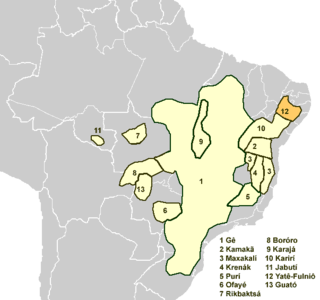
Fulniô, or Yatê, is a language isolate of Brazil, and the only indigenous language remaining in the northeastern part of that country. The two dialects, Fulniô and Yatê, are very close. The Fulniô dialect is used primarily during a three-month religious retreat. Today, the language is spoken in Águas Belas, Pernambuco.
Alas (East Timor) is a town in Alas Subdistrict. It is located in the interior of the island, 294 metres above sea level. As the crow flies, Alas is 56 km southeast of the state capital Dili und 7 km to the East of Same. Alas lies to the North of the Suco of Mahaquidan (Malaquidan, Malagidan), and the Alas suburbs of Uma Mean (Umanican, Umamean) and Beremanek are located in Mahaquidan. The suburbs of Lurin und Ailora are in the suco of Taitudac (Taitudak, Taitudac, Taitudal). It is located in the interior of the island, 294 metres above sea level. As the crow flies, Alas is 56 km southeast of the state capital Dili und 7 km to the East of Same. Alas lies to the North of the Suco of Mahaquidan (Malaquidan, Malagidan), and the Alas suburbs of Uma Mean (Umanican, Umamean) and Beremanek are located in Mahaquidan. The suburbs of Lurin und Ailora are in the suco of Taitudac (Taitudak, Taitudac, Taitudal). There is a medical station and a helicopter in Alas, as well as a primary school (Escola primaria Alas Vila) and a pre-secondary school.

Idalaka is a Malayo-Polynesian dialect chain spoken in East Timor. The name is a portmanteau of Idaté and Lakalai.

The Mambai people are the second largest ethnic group after the Tetum Dili people in East Timor. Originally, they were known as the Maubere by the Portuguese. Maubere or Mau Bere is a widespread male first name among the Mambai people.

Loro Munu refers to the western part of East Timor. In the past, the name was used for the western part of the island of Timor, as "Loro Munu" means setting sun or simply west.
